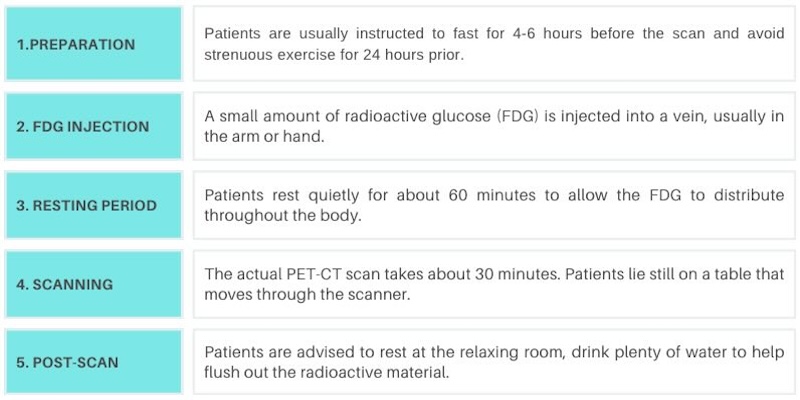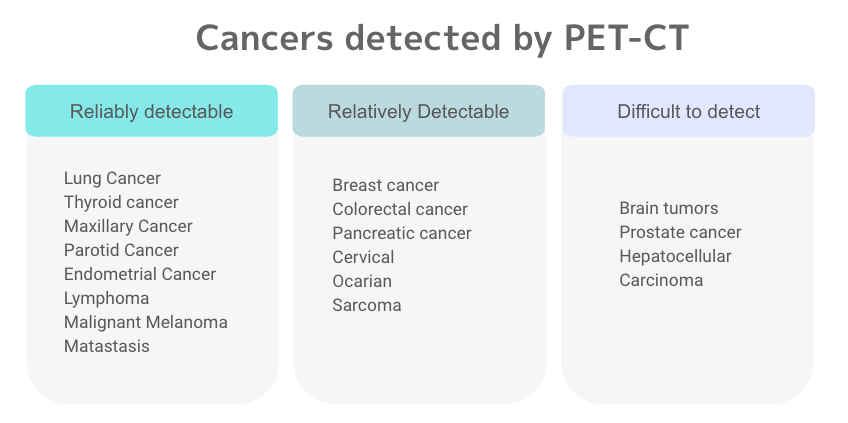Positron Emission Tomography-Computed Tomography (PET-CT) is a cutting-edge medical imaging technology that has revolutionized the field of diagnostic medicine, particularly in oncology. This article aims to provide comprehensive information about PET-CT scans, their benefits, and their application in Japan’s medical tourism industry. For those considering medical tourism to Japan, understanding the advantages of PET-CT scans can be crucial in making informed decisions about their health care.
What is PET-CT?
PET-CT is a hybrid imaging technique that combines two powerful diagnostic tools: Positron Emission Tomography (PET) and Computed Tomography (CT). This combination provides both metabolic and anatomical information in a single examination, offering a more comprehensive view of the body’s functions and structures[1].
PET imaging uses a small amount of radioactive glucose (FDG) injected into the patient’s bloodstream. Cancer cells, being more metabolically active, absorb more of this glucose than normal cells. The PET scanner detects the radiation emitted by the FDG, creating images that show areas of high metabolic activity, which often indicate the presence of cancer.
CT, on the other hand, uses X-rays to create detailed cross-sectional images of the body’s anatomy. When combined with PET, it provides precise localization of abnormal metabolic activity, enhancing the accuracy of diagnosis.
Background of PET-CT Screening in Japan
Japan has been at the forefront of adopting PET-CT technology for cancer screening. The country’s aging population and the increasing incidence of cancer have driven the demand for advanced diagnostic tools. In 2024, a survey conducted by Japan Radioisotope Association showed around 400 PET-CT machines are used in the medical institutions in Japan and reported that there were more than 43,000 scanning examinations operated in 2024.
The Japanese government has recognized the potential of PET-CT in early cancer detection and has included it in some cancer screening programs. This has made PET-CT more accessible to the general population and has contributed to Japan’s reputation as a leader in preventive medicine.
PET-CT Screening Process
The PET-CT scan typically takes about 30 minutes to complete, with the entire process, including preparation, lasting about 2-3 hours.
The typical PET-CT screening process in Japan involves the following steps:

Diseases Detectable by PET-CT Screening
PET-CT scans are particularly effective in the early detection of various diseases, especially cancer. Some of the conditions that can be identified through PET-CT screening include:
- Cancer: PET-CT can detect many types of cancer at an early stage, often before they are visible on other imaging methods.
- Cardiovascular diseases: It can assess blood flow to the heart and detect coronary artery disease.
- Neurological disorders: PET-CT is useful in diagnosing conditions such as Alzheimer’s disease, Parkinson’s disease, and epilepsy.
- Inflammatory and infectious diseases: It can help identify areas of inflammation or infection in the body.
Cancer Types PET-CT Excels at Detecting
PET-CT is particularly effective in detecting and staging certain types of cancer:
- Lung cancer: PET-CT can detect lung nodules as small as 5mm.
- Colorectal cancer: It’s highly effective in staging and restaging colorectal cancer.
- Lymphoma: PET-CT is excellent at detecting lymph node involvement.
- Breast cancer: It can help in staging and monitoring treatment response.
- Head and neck cancers: PET-CT is valuable in diagnosis, staging, and post-treatment evaluation.
- Melanoma: Whole-body PET-CT is considered the best method for accurately staging melanoma.
However, PET-CT has limitations in detecting some cancers:
- Brain tumors: The high glucose metabolism of normal brain tissue can mask tumors.
- Prostate cancer: FDG uptake can be low in some prostate cancers.
- Hepatocellular carcinoma: The liver’s high background FDG uptake can make detection challenging.

Conclusion
PET-CT scanning represents a significant advancement in medical imaging, offering unparalleled capabilities in the early detection and staging of various diseases, particularly cancer. For those considering medical tourism to Japan, the country’s expertise in PET-CT technology and its widespread availability makes it an attractive destination for comprehensive health screenings.
The ability of PET-CT to detect cancers at an early stage, often before they become symptomatic, can significantly improve treatment outcomes and survival rates. A study in Japan found that among asymptomatic individuals undergoing PET-CT screening, 1.1% were diagnosed with cancer, most at an early stage.
While PET-CT is a powerful diagnostic tool, it’s important to note that it should be used judiciously, considering the radiation exposure. However, for those at high risk of cancer or with suspicious symptoms, the benefits of PET-CT screening can far outweigh the risks.
Japan’s advanced healthcare system, combined with its expertise in PET-CT technology, makes it a prime destination for those seeking comprehensive and accurate health assessments. As medical tourism continues to grow, PET-CT screening in Japan offers a compelling option for individuals.
<References>
1. Hospital Clínic Barcelona. (2021). What is PET-CT? Retrieved from https://www.clinicbarcelona.org/en/assistance/tests-and-procedures/pet-ct
2. Johns Hopkins Medicine. (n.d.). Positron Emission Tomography (PET). Retrieved from https://www.hopkinsmedicine.org/health/treatment-tests-and-therapies/positron-emission-tomography-pet
3. Rhode Island Hospital. (n.d.). What is PET/CT Used For? Retrieved from https://www.brownhealth.org/centers-services/pet-ct/pet-ct-uses
4. Kiranpet Nuclear Medicine & PET/CT Centre. (2024). Top 5 Benefits of Getting a PET CT Scan for Early Detection. Retrieved from https://kiranpetct.com/top-5-benefits-of-getting-a-pet-ct-scan-for-early-detection/
5. Chen, Y. K., et al. (2020). Comparison of FDG-PET/CT for Cancer Detection in Populations with Different Cancer Prevalence. Oncology, 98(1), 1-9.
6. Minamimoto, R., et al. (2012). The current status of an FDG-PET cancer screening program in Japan, based on a 4-year (2006–2009) nationwide survey. Annals of Nuclear Medicine, 27(1), 46-57.
7. Radiologyinfo.org. (2023). PET/CT. Retrieved from https://www.radiologyinfo.org/en/info/pet
8. King’s College Hospital NHS Foundation Trust. (2024). PET-CT scan. Retrieved from https://www.kch.nhs.uk/services/cancer/tests-and-investigations/pet-ct-scan/
9. Stanford Health Care. (n.d.). How PET Scans Work. Retrieved from https://stanfordhealthcare.org/medical-tests/p/pet-scan/what-to-expect.html
10. University of Maryland Medical System. (n.d.). PET/CT Scan for Cancer. Retrieved from https://www.umms.org/ummc/health-services/imaging/diagnostic/pet-scan/cancer
